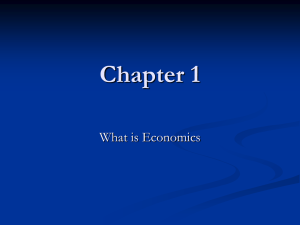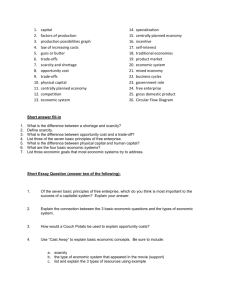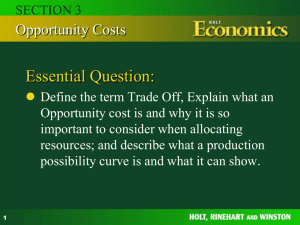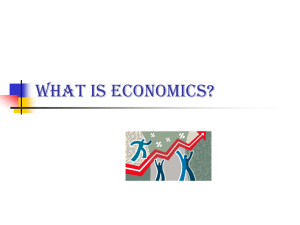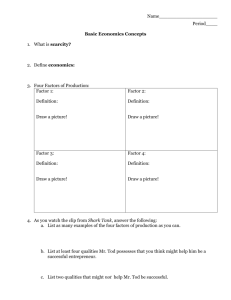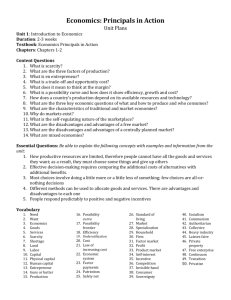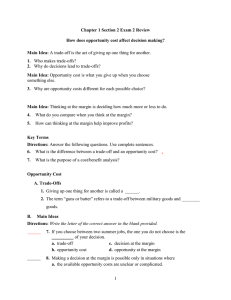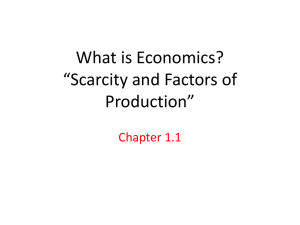Opportunity Cost - North Clackamas School District
advertisement
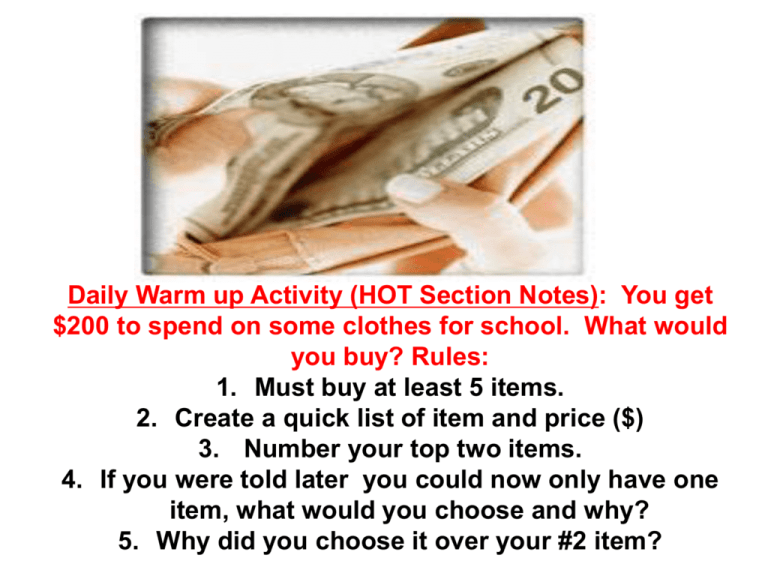
Daily Warm up Activity (HOT Section Notes): You get $200 to spend on some clothes for school. What would you buy? Rules: 1. Must buy at least 5 items. 2. Create a quick list of item and price ($) 3. Number your top two items. 4. If you were told later you could now only have one item, what would you choose and why? 5. Why did you choose it over your #2 item? Daily Warm Up Question Name the four factors of production and give two examples of each. Give two examples of entrepreneurs in the world today that you know of and or admire. What business are they in and how have they helped the economy? Unit One: Learning Objectives: North Clackamas School District Social Studies Priority Standards: • Econ 53. Describe characteristics of command, market, traditional, and mixed economies and how they affect jobs and standards of living. • Econ 59. Demonstrate the skills and dispositions needed to be a critical consumer of information. Lesson Two: Daily Learning Target I Can define and explain in writing the following key Economic concepts: Trade-offs Opportunity Cost Thinking at the Margin ECONOMICS Review from lesson #1….. Hot Question #1: What is scarcity? Scarcity exists. We have endless desires but limited resources. In Economics, we must choose. H.O.T. Question # 2: Define “Trade-off” in your own words and give an example. • A trade-off occurs when we choose one course of action over another or one benefit over another . (K.I.M. Vocabulary Definition #1) • In Economics, we can never have everything we want or need. • We must make choices. • A woman spends ten dollars buying her lunch at a local restaurant. She cannot use the same ten dollars to buy a book. A trade-off has occurred. Again….It’s All About Scarcity! • Scarcity exists. Our wants and desires are limitless but our natural resources are limited. • We can always want more than we have. As such, we are constantly choosing one course of action over another. • We cannot spend ten dollars on a movie ticket and the same ten dollars on a restaurant meal. H.O.T. Question #3: What are the tradeoffs in the following scenarios (what benefit do you lose or give up?) 1. Dre works on his homework until 3:00 A.M. in the morning to prepare for his test at 7:00 AM at O.S.U. 2. Mr. Kirby blows his entire paycheck at Spirit Mt. Casino at the blackjack table. 3. Mr. Seymour takes out all his money from his retirement account to use as a down payment on a house. 4. A farmer wants to plant corn, broccoli and wheat on his property, but only plants wheat. 5. The government during war time decides to use all of it’s steel to produce tanks and ships. Opportunity Cost (K.I.M. Vocabulary #2) • Whenever we make a decision, we receive one thing but give other things up. • If I chose to study tonight for the examination, I cannot go to the party or the movies or walk the dog. • The most desirable alternative given up for the decision is the opportunity cost. • Think of the opportunity cost as the best course of action of all those things you didn’t get OR • The most prized things(s) you gave up when making a decision. Opportunity Cost Continued: HOT Questions: 4. What is the opportunity cost of you deciding to get up every morning at 5:00 A.M. and go for a 5 mile run. 5. What is the opportunity cost of you getting a job next week working on the weekends. 12 Scarcity, Choice, and Opportunity Cost Limited Resources & Unlimited Wants Scarcity Choices Opportunity Cost 13 The World of Trade-Offs • Opportunity cost graphically – The production possibilities curve (PPC) represents all possible maximum combinations of total output that could be produced. – Along the production possibilities curve, there is a fixed quantity of productive resources of a given quality being used efficiently. 14 Production Possibilities Curve for Grades in Mathematics and Economics (Trade-Offs) 0 Increments of 3 Hours 15 Production Possibilities Curve (PPC) HOT Questions: 6. What would happen to the production possibilities curve if you spent more time studying? 7. What would happen to your potential grades? 8. Is it possible that terms of the trade-off might not be constant? 16 Scarcity and opportunity costs affect individuals, businesses, and governments. HOT Question #9: What does Guns or Butter mean in economics? • Government officials also must choose where to spend tax dollars. • When a government spends more money on the military, it must invariably spend less money on consumer goods like roads and schools. • Economists refer to government trade-offs as Guns or Butter. The Cost of War Thinking at the Margin: KIM Vocabulary #3 • Sometimes a decision involves whether to add or subtract one additional unit of a resource. • After studying many hours, a student might ask herself: “Should I study one more hour?” • This question is a question at the margin. Deciding whether to add or subtract one additional unit occurs at the margin. Should we study one more hour? That is thinking at the margin. HOT Questions for Reflection: Discuss in groups: write your answers in your notes. 10. Provide examples of trade-offs. 11. Why do trade-offs exist? 12. What is “the opportunity cost”? 13. Provide an example of an opportunity cost? Summary Paragraph What is thinking at the margin? Provide an example of thinking at the margin in the space provided. Problem Solving Activity #3 Grab an economics book with a partner off the shelf; Turn to page 12-Complete “Critical thinking questions” 7-9 on page 12 and turn into Mr. Kirby before the End of the period. Problem Solving Activity #3


